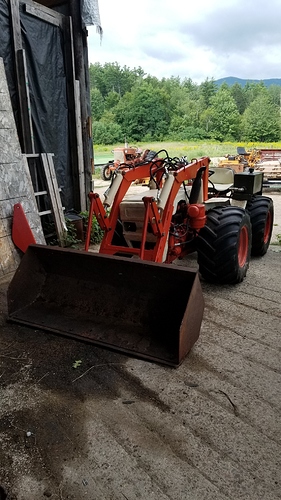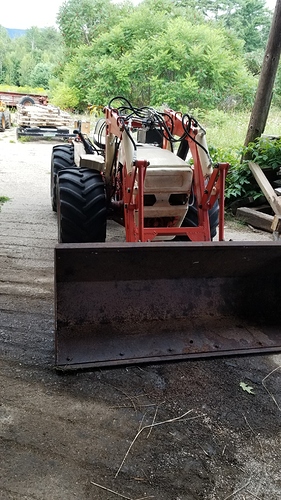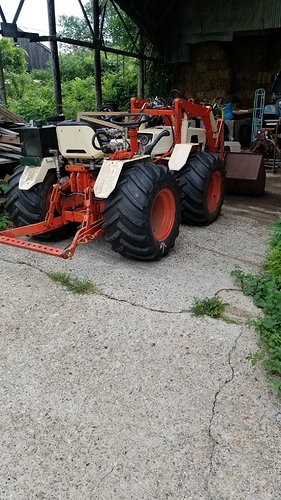I was thinking about just one cylinder that extends and retracts
The only issue I can see with 1 cycle is the volume when the cylinder is retracted needs to be available in the tank to handle it. You should be ok but if it comes up short of volume it will blow oil out of the tank. The loader will do that on mine. Just keep in mind two on opposite sides of the pivot will solve that issue if you find it happening.
Oh I forgot to mention don’t loose those rims they are gold. I had to repair my rear rims because they where loaded with Calcium chloride and rusted out. You can’t get rims in the states which match the pasquali they are either order from Italy or custom made. I debated cutting the centers out of mine and putting them into new hoops but that would change the tire width and I have good rubber so instead I just had a friend weld patches all around the inside there might even be a photo of the repair here I can’t remember. But without the rear tires loaded and with a loader (I suspect with the blade it is the same) my tractor would just wag it’s tail when you turned the wheel and continue to go in a straight line. That was a lot of fun until I got the counterweight on it. I think once I load the rear tires again it will be ok. My goal is to use it for field work as well as a loader tractor I might have to take the bucket off for field work we will see.
I have tubes in all 4 rims now they are not cheap but money well spent with old rims and old rubber.
Thanks for the info Dan, I plan on taking the fluid out for that reason, rotting. The extra rims I have are for dual wheel setup, I’m pretty sure I could retro them if the others rot out… I’ll have to keep my eyes peeled on C-list for cylinders. I don’t know a thing about hydraulics but I’m learning…
I will be reloading the rear tires with Rim Guard. I don’t have the wheel weights for mine.
Around here it is the only product you can get installed professionally anyway so I would have to load them myself if I wanted to use salt. But if you don’t have the weight on the rear end you can not steer the pasquali I have seen that first hand and I don’t want to just leave a counter weight on it all the time that is a real pain and limits what I can do with it. I still believe in tubes even with the new fluid simply because the rims are so old and beat up I don’t want to depend on the beads holding air. Maybe that is paranoid but I will find myself in the woods on the back side of my swamp a mile from the house with it and I really don’t want a flat.
As to hydraulics. Honestly I would order the cylinders you want for your project. If you buy used you will probably end up having to rebuild them with new seal kits and in the end you will spend almost as much as for new. And that assumes the cylinders are rebuildable if there is rust on the inside of the cylinder rebuilding them is more expensive then new. I have one like that on my other loader tractor but it is an odd cycle and would have to have been custom built either way. The link above to surplus center is where I get my hydraulics. You will need Banjo fitting to plumb into the Pasquali hydraulic loop you can get banjo to JIC fitting from Jegs Performance.
https://www.jegs.com/i/Unisteer/668/8021560/10002/-1
I think that is the one the pasquali uses but you will want to measure them to know for sure and the hoses are at surplus center. Infact I need to place an order for all new hoses for mine. It is one of the issues mine where failing do to age so I am simply going to replace them all and not have to deal with any issues going forward.
The pasquali has what is called open central hydraulics. The basics on adding a new control valve is plumb them in serries so take the output of something after the steering valve and plumb it into the new valve bank input. Then plumb the output of your new valve to where the output of the old valve went to complete the loop.
First I would see what the current raise and lower control valve is for the blade and if you can add a spool to the valve bank. Odds are you can’t but sometimes you get lucky.
I said after the steering because in an open center system the first valve gets priority and you definitely always want it to steer.
Oh I was just thinking for the winter plowing you might be better off with the narrow rims and tires. You will get better traction with a single set of those they also have thicker tread depth on the lugs being true R1. The tread is the main advantage to the duals. It is how the tractor was designed the flotation rims are actually too heavy for the tractor when loaded. I think it was on Italian tractor parts where I read that you have to be careful if you load flotation tires on the pasquali.
Tubes are definatley the way to go. How do you evac the fluid, take it to a tire shop?? I don’t think I need fluid on the fronts, maybe the rear but I plan on leaving the tiller on while plowing for rear weight I know that plow and frame are plenty heavy…
You don’t want fluid in the front. The idea behind loading the rears is because the front half of the tractor is heavier then the rear and it needs to be more balanced to pivot correctly.
The best thing is to take the tire to the shop. Old timers will pull the drain plug and dump the salt where they don’t want anything to grow. It isn’t considered hazardous it is the same basic stuff they put on the road. But you have to break down the tires and wash them to get it all out. I had the tire shop break them down for me because I couldn’t break the beads on those. Too shallow of a side wall on the wide tires to get without the right tools. Then I brought my rims home cleaned, repaired and painted them before taking them back to the tire shop to be mounted. Once I have the tractor finished I will rake it down there and get them loaded on the tractor. It is much better not to deal with loaded tires off the machine they are dangerously heavy you definitely don’t want one to fall on you.
My advice would be to try to plow with unloaded front tires and loaded rear tires with no tiller first. If that will work you will greatly appreciate the ability to backup without hitting your tiller on things. Not that I have ever backed my counterweight into something…
exactly my thinking, I’ll let the tire shop pump out the juice. I would rather drain the fluid from the rears as well, just do away with it all together and put a concrete filled weight on the back to counter the front plow. I don’t much care for my wheels rotting out. By the looks of things I’m sure the calcium has been in there for a while and I’ll need to do some fabing…
It has been there the entire life of the tractor is my bet. The new stuff will not rust the rims it is chemical safe for them. If you go the counter weight route there are 2 potential issues. One you always have the weight on the 3 point hitch over time that will cause it to drift down. Second it defeats the ability to use the tractor as a tractor with a implement on the rear. Ok 3 things all the weight is on the wheel bearings. Loaded tires or wheel weights are unsprung weight and won’t damage your wheel bearings. I have no fear of the new Rim Guard fluid it is environmentally safe and metal friendly. I have it in my Allis Chalmers D15 loader tractor rear tires. My hay grapple for that one is so heavy I also have a counter weight but as soon as haying season is over I take the counter weight off. Ironically I use an old broken tiller for the weight that and some wheel weights which don’t fit that tractor.
Oh the other issue is the amount of weight loaded tires give you much more weight then wheel weights if you can find the weights that match the tractor.
Dan- just found this site & thread. I’m currently restoring a 987 (may actually be a 997–it’s stamped 987 but I can’t tell which Ruggerini engine it has). Looks like you did a very thorough job–it looks great. I can use as much help as I can get, so I hope you see this and respond. Specifically: how did you make your own bushings for the barrel pivot? Do you have any pictures of that process? I haven’t taken mine completely apart yet, but it’s got some slop, so I bet mine will look similar to yours. Any advice is appreciated.
Ben your machine looks nicer them mine did when I started. The pivot on my tractor was broken and repaired making it out if round by the last owner. What I did was simply build up fiberglass the cloth type on the inside of the outer part sanding it down till I had a nice fit between the two. If there are no photos about I didn’t think to take any. I tried to do a pour casting with the resin but that didn’t work it just didn’t seem to stick and harden good. Then I drilled the grease fitting and added one to the other side of the pivot. No idea how well it will work out but I got a nice fit and the old material was not as strong as fiberglass felt like a plastic or paper loaded with grease was all that was in mine before I fixed it.
I still need to get my hydraulics put back together and I am adding a 5 gallon oil tank the small tank on the front was broken on mine anyway and too small for the loader. I will also be adding a rear remote it will probably be slow but in time I want to build a dump trailer for it.
I have pretty much put the pasquali on hold due to cold and a lack of a heated space to work on it.
Hope that is helpful they are great tractors and I would love to see another one saved. I can’t say enough good things about Tom Branch up in Canada without his advice and parts I couldn’t have restored mine.
Thanks for the input. I’ll let you know what I find. I’m also planning to make an auxiliary oil tank of 2-3 gallons next to the battery and connecting it to the existing tank–which is really too small to handle the loader. I have worked with Tom for parts–I agree that without him or his website I wouldn’t be attempting this.
I have a tractor with 2 tanks. The tank that you plumb the return to has to be sealed no fill cap or it will definitely overflow and the the connection between the 2 tanks is a real issue for flow. The 5 gallon tank on the fender is my plan that tank was pretty cheap from surplus center as well. Just my 2 cents of advice learned the hard way on my allis Chalmers d15.
Just a update the pasquali isn’t 100% how I want it but it is back out in the field this summer raking hay for me. There are a bunch of little things left to do and adjust but I have finial found the time this spring to get it back to a usable state after way too long.
Needless to say I will be following the effort of others to make a form of diesel fuel from wood because there isn’t much spare room on that tractor for a gasifer. I have considered running vegetable oil through a pre heater but my mechanic advised against it. Time will tell it always does.
Dan; A long process but it sure came out nice. TomC
Thanks it takes forever when you are short on both time and money. It seems in life a surplus of one can help with the other but when both are lacking time delays result.
DanA long before wood-to-a-drop-in-liquid-diesel would ever be worth it . . . .
selected plastics today is possible.
I would be remiss not pointing out some of the real today work on this done by some such as Ben Peterson.
Yep. I hate plastics myself and refuse to work with them for energy solutions.
To me they are in the volumes needed for useable amounts of fuel only Urban waste generated.
Living Rural I think only in closed cycle Rural solutions for those who have chosen to Rural live.
You machine farm. So I would go with a site grown vegetable oil solution.
Those Austrian farmer got way off base asking for a University chemical solution to their engines vegetable residue carboning up.
The Essbet folk originally out of the Netherlands are the one doing the needs and conversions to diesel engines fuel with neat vegetable oils long term.
And was a Kansas commercial sunflower oil farmer who did prove some great work with just 10% cutting his raw sunflower oil with regular unleaded gasoline for working use in his unmodified tractors and trucks.
Hah. He stopped posting cause he was shouted down by the committed, many steps chemical, bio-diesel DYI’ers. And they always coming onto woodgas forums looking for gasifier solutions for disposal of their methional contaminated sludges.
Missing the whole point of using their diesel engines as the burn it all up plant grown direct making heat and power just as a normal course.
Seems to be a modern expression human nature thing . . . unless woo-woo complex with lots of exotica it just cannot be real, and possible.
Regards
Steve unruh
I am definitely looking into that path. It is just low on my project list
That is very interesting. I am assuming I have an endless supply of used vegetable oil available in this tourist town if I get a process to use it. That is why I have read alot about the diesel rabbits people run in straight vegetable oil heated to get the correct viscosity. But with an air cooled diesel that isn’t straight forward. Could still be done I am sure there is plenty of waste heat just not an easy to get to hot water source.
Thanks for the ideas I will continue to kick them around. If for no other reason free fuel from the waste stream in town is a win win in my book.



